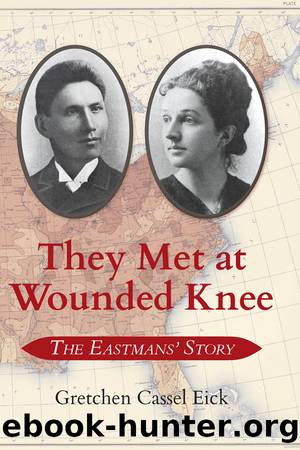They Met at Wounded Knee by Gretchen Cassel Eick;

Author:Gretchen Cassel Eick; [Неизв.]
Language: eng
Format: epub
ISBN: 9781948908733
Publisher: Chicago Distribution Center (CDC Presses)
Figure 21.1 Booker T. Washington, between 1905 and 1915. Harris & Ewing Photograph Collection, Prints and Photographs Division, Library of Congress. https://www.loc.gov/item/2016857180/.
Washington was a contemporary of Teddy Roosevelt and Charles Eastman, but he was born into slavery. His autobiography Up from Slavery, published in 1901, a year before Charles Eastmanâs Indian Boyhood, chronicled his journey from a West Virginia slave cabin, to Hampton Institute, to founding Tuskegee Institute in Alabama. Washington included his experience escorting an Indian boy from Hampton to Washington, DC. On a ferryboat, Washington was refused permission to eat in the dining room, while the Native American boy he was escorting ate with whites, although his skin was darker than Washingtonâs. As he said, âIf a person is known to have one-percent of African blood in his veins, he ceases to be a white man.â4 This became known as the one drop theory.
âRaceâ was used around the globe to justify conquest of indigenous land. Its use varied from continent to continent. Within the United States, it was applied differently to people of African descent and people of indigenous descent. Each so-called race lived within different restrictive parameters.
The difference was evident at Hampton Institute, where Elaine had first taught. Indians could not leave school even for family emergencies, but black students could. Native Americans were not segregated on the railroad cars, but African Americans were.5
Booker T. Washington promoted black vocational education, black businesses, social separation, and collaborative economic development. Meanwhile, murder of black men and women by white mobs (lynching) and laws reducing the black vote proliferated, which Washington named in his 1899 book, The Future of the American Negro.
In 1898, Louisiana adopted a grandfather clause allowing only those who could vote before 1867 to vote. Because blacks could not vote until the Fifteenth Amendment to the US Constitution was ratified in 1870, grandfather clauses prevented them from voting. Alabama adopted a new constitution with a similar provision. Literacy and property tests were required in order to vote across the South. In 1902, Virginia required voters to pay a retroactive poll tax to vote and to pass an âunderstanding testâ on the Constitution. That eliminated 93 percent of Virginiaâs black registered voters over the next four years. The US Supreme Court upheld these laws in 1903.
Meanwhile an epidemic of racially motivated white-against-black violence spread across the South, beginning in 1898 in Wilmington, North Carolina, and in New Orleans, Louisiana, and New York City in 1900. In 1906, white-against-black race riots erupted in Atlanta, Georgia, and Brownsville, Texas, then in 1908, in Springfield, Illinois, and in 1910, in Houston, New York, St. Louis, Omaha, New Orleans, Little Rock, and Los Angeles. White violence against non-whites kept spreading. Although most of the victims were black, a recent study of 4,800 lynchings in the United States found that 137 of the victims were Native American.6
In short, African Americans like Native Americans were living through a traumatic and devastating time characterized by steady deterioration of their legal rights, stark changes in the dominant cultureâs perception of them, and unprovoked violence.
Download
This site does not store any files on its server. We only index and link to content provided by other sites. Please contact the content providers to delete copyright contents if any and email us, we'll remove relevant links or contents immediately.
The Dawn of Everything by David Graeber & David Wengrow(1568)
The Bomber Mafia by Malcolm Gladwell(1519)
Facing the Mountain by Daniel James Brown(1428)
Submerged Prehistory by Benjamin Jonathan; & Clive Bonsall & Catriona Pickard & Anders Fischer(1375)
Tip Top by Bill James(1291)
Wandering in Strange Lands by Morgan Jerkins(1281)
Evil Geniuses: The Unmaking of America: A Recent History by Kurt Andersen(1269)
Red Roulette : An Insider's Story of Wealth, Power, Corruption, and Vengeance in Today's China (9781982156176) by Shum Desmond(1267)
The Way of Fire and Ice: The Living Tradition of Norse Paganism by Ryan Smith(1259)
Driving While Brown: Sheriff Joe Arpaio Versus the Latino Resistance by Terry Greene Sterling & Jude Joffe-Block(1230)
American Kompromat by Craig Unger(1213)
F*cking History by The Captain(1196)
It Was All a Lie by Stuart Stevens;(1191)
American Dreams by Unknown(1153)
Treasure Islands: Tax Havens and the Men who Stole the World by Nicholas Shaxson(1152)
Evil Geniuses by Kurt Andersen(1143)
White House Inc. by Dan Alexander(1122)
The First Conspiracy by Brad Meltzer & Josh Mensch(1075)
The Fifteen Biggest Lies about the Economy: And Everything Else the Right Doesn't Want You to Know about Taxes, Jobs, and Corporate America by Joshua Holland(1030)
